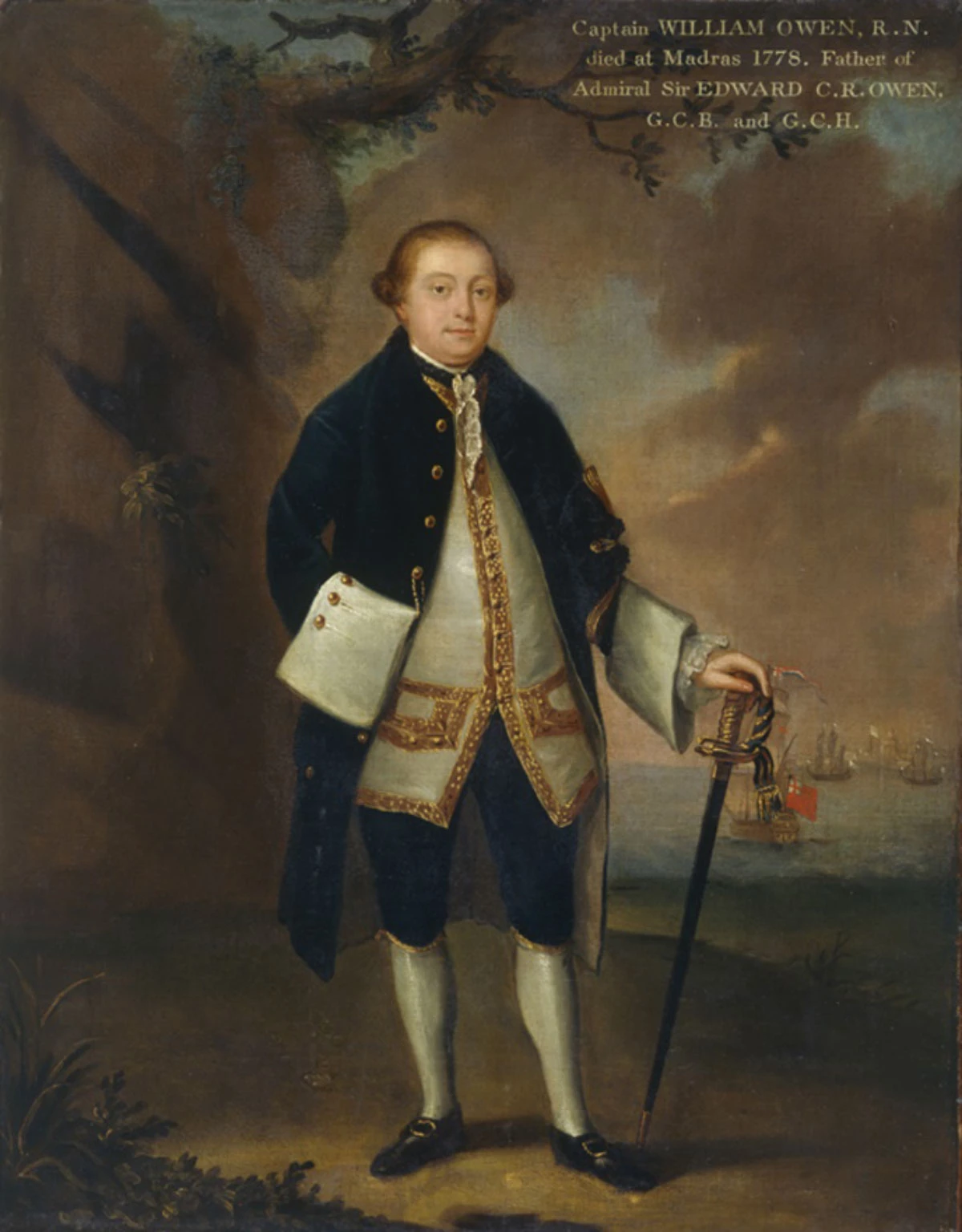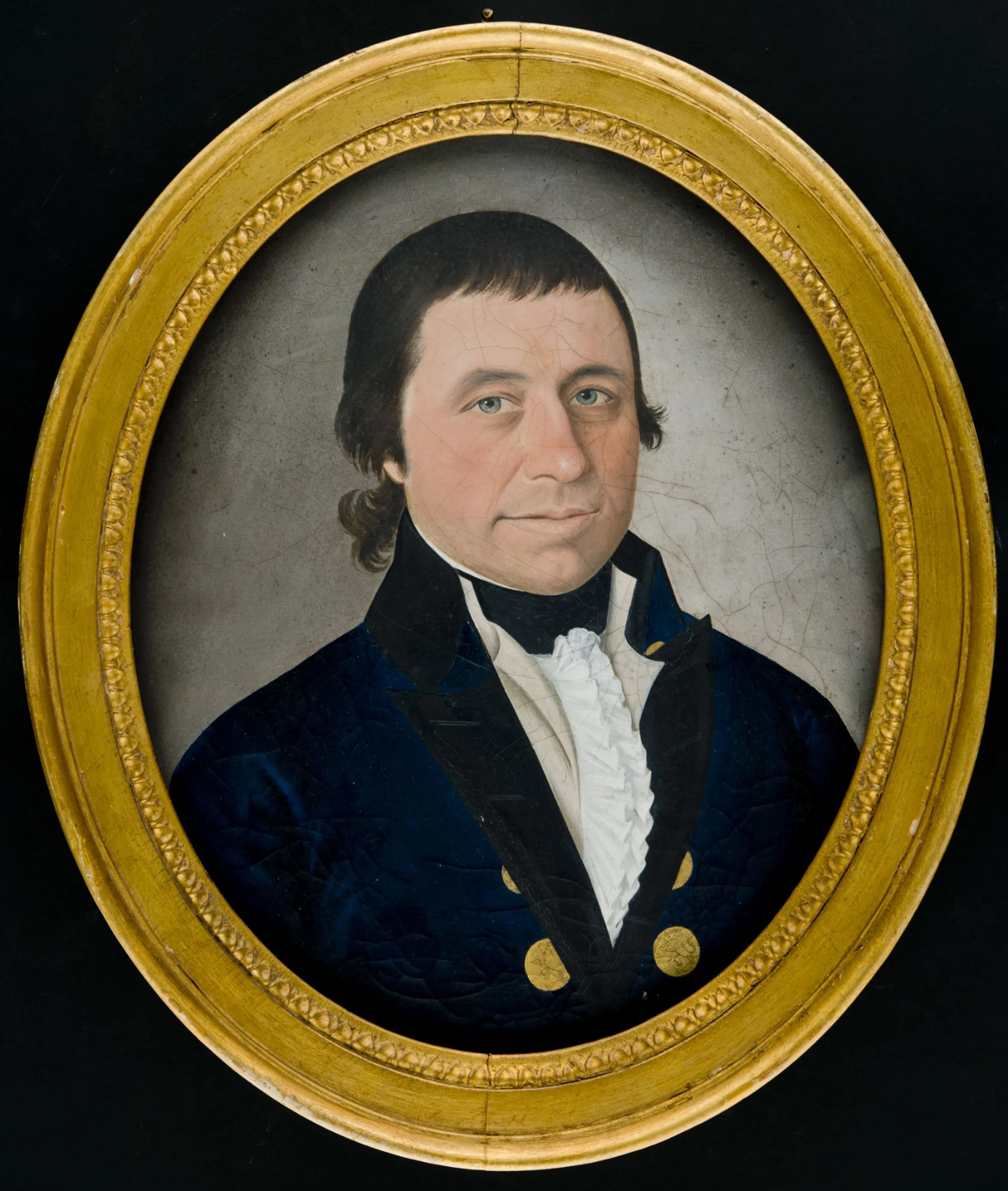Welsh participation in the development of Britain’s maritime empire
Two portraits illustrate Welsh participation in the development of Britain’s maritime empire. One of these, a small full-length measuring 54.5 x 42.6 cm, was painted around 1764. Its subject is William Owen (1737-1778). The other was made in Canton, China, perhaps in 1791, and is of John Jones (1751-1828), a Captain in the service of the East India Company.
William Owen
William Owen (1737-1778)
William Owen came from a Montgomeryshire gentry family, the Owens of Cefyn-yr-Hafodau. Life at sea was dangerous, and progress up the career ladder was difficult and required influence as well as talent. However, it was a socially appropriate career for a gentleman, it required little investment, and there was the remote possibility of making a fortune from prize money.
Families had to persuade a Captain to accept their son on board as ‘a young gentleman’ to build up the six years’ service needed to qualify as a Lieutenant. William’s father obtained a recommendation to the Secretary of the Admiralty who placed the boy with his son-in-law. William served in West Africa and the West Indies, before sailing for India in 1754. He was to be in India for a hectic seven years, while Britain was at war with France.
William fought on land at the Battle of Plassey as well as at sea, being wounded with a musket ball. William, who was promoted Lieutenant in 1758, also took part in the blockade of the French base of Pondicherry and was again wounded in an attack on two French ships in the harbour.
In his portrait, Owen is wearing the uniform of a Lieutenant in the Royal Navy (pattern of 1748-1767). Part of his right arm is missing, as he explains in an account of his services:
‘on the night of 7 Oct 1760 he [was] ordered to cut out the French ships La Baleine and Hermoine from under the guns of Pondicherry, … [when] he had the misfortune to have his right arm shot off … by a Cannon Ball’.
Owen went on half-pay when the war ended in November 1762. Promotion in the Navy was slow in peacetime and in 1766 he accompanied Lord William Campbell, newly appointed as governor, to Nova Scotia. Campbell granted him an island in Passamaquoddy Bay (between New Brunswick and Maine). By 1771 there were seventy-three settlers on Owen’s island. As Britain and Spain then appeared close to war, he returned to England. However it was not until 1776 that he was recommissioned and ordered to India. Promotion followed and he was made Commander into the sloop HMS Cormorant. William did not live to see the end of that war as he was killed in a drunken accident in Madras in October 1778.
John Jones
John Jones (1751-1828)
The subject of the other portrait, John Jones was born in Swansea in August 1751. He came from a middle-class family, and was apprenticed a merchant seaman in the West India trade, He then served on the East India Company’s ship Queen, on a voyage to Madras and China in 1770-1772. On his return he joined the Royal Navy. In 1773 Britain was at peace, and he probably did so in the hope of improving his social as well as his professional status. He was less obviously officer-class than William Owen, and served as a Master, the warrant officer responsible for navigation, before being commissioned Lieutenant in 1782 at the end of the American War. He was now out of a job and re-joined the East India Company which he served for the next fifteen years. He was 1st Mate on the Carnatic in 1786-7, and of the Deptford in 1787-9. He was then appointed Captain of the East Indiaman Boddam, making three voyages to China in 1791-2, 1793-4 and 1800-1.
His private ledger survives for his first voyage in the Boddam and reveals that he invested £11,000 in goods to be sold in Madras and Canton including a pack of fox hounds, making a personal profit of nearly £4,000. He was then able to invest £7,500 in Chinese goods in Canton, which would have sold for a further profit in London.
His portrait was painted by Guan Zuolin, a Chinese artist active in Canton between 1770 and 1805. He worked in a flat, clear-cut European style using oils thinned with water. In 1794 Jones bought St Helen’s House, overlooking Swansea bay, which was rebuilt for him as a neo-classical villa by the architect William Jernegan. A view of about 1800 shows it set in its own parkland, grazed by Jones’s horses, cattle and sheep. Here he passed a comfortable retirement until his death in a carriage accident in 1828.
St Helen’s House


Comments - (1)
Captain John Jones is my great (times 5) Grandfather on my mother's side. We are researching our family history and it would be fantastic if you had anymore information on him such as his relations, work history etc. That we could use to build a better picture of him.
Please could you contact men on the email address provided.
kind regards
Gemma